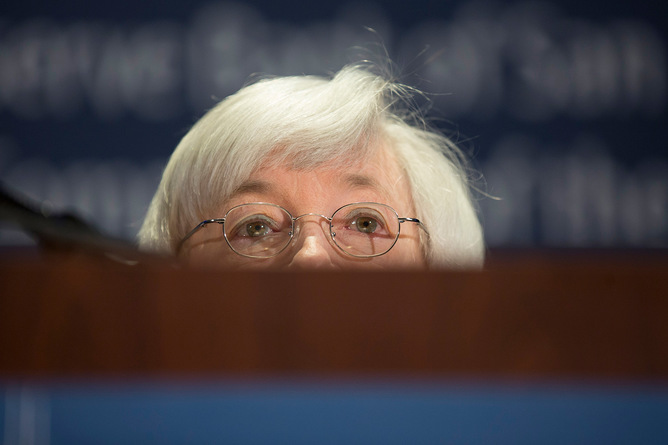What is the Fed's idea of 'normal'?
by Tim Duy
Monday Federal Reserve Vice Chair Stanley Fischer offered up a speech and lengthy discussion on recent monetary policy. It was both illuminating and frustrating at once. Although his confidence is fading, I also sense that he is resisting change. Fischer begins by reviewing the December decision:
Our decision in December was based on the substantial improvement in the labor market and the Committee's confidence that inflation would return to our 2 percent goal over the medium term. Employment growth last year averaged a solid 220,000 per month, and the unemployment rate declined from 5.6 percent to 5.0 percent over the course of 2015. Inflation ran well below our target last year, held down by the transitory effects of declines in crude oil prices and also in the prices of non-oil imports. Prices for these goods have fallen further and for longer than expected. Once these oil and import prices stop falling and level out, their effects on inflation will dissipate, which is why we expect that inflation will rise to 2 percent over the medium term, supported by a further strengthening in labor market conditions.
This covers familiar territory, as does his subsequent remarks the even after raising rates, policy remains accommodative:
I would note that our monetary policy remains accommodative after the small increase in the federal funds rate adopted in December. And my colleagues and I anticipate that economic conditions will evolve in a manner that will warrant only gradual increases in the federal funds rate, and that the federal funds rate is likely to remain, for some time, below the levels that we expect to prevail in the longer run.
This is the first source of my frustration, because his definition of "accommodative" depends upon a specific idea of the neutral Fed Funds rates. From the subsequent discussion:
Well, I think we have to wait to see precisely where this process will take us. We expect now that the numbers given in the survey, we can now make projections, the SEP of members of the FOMC, of somewhere around 3 ¼, 3, 3 ½ percent, which is on average a bit lower than in the past. But we’ll be data-dependent and we’ll see what happens. We don’t have to fix a rate that we’ll be at. We can indicate what members of the FOMC believe, which is what the number I’ve just given you is.
If you don't know the longer-run rate, how can you know how accommodative policy is? If the longer-run rate is close to 2 percent, then policy is less accommodative than you think it is. The endgame of policy is the dual employment/price stability mandate, not a specific level of interest rates.
The Fed's forecasts, however, have been foiled by oil and the dollar:
At our meeting last week, we left our target for the federal funds rate unchanged. Economic data over the intermeeting period suggested that improvement in labor market conditions continued even as economic growth slowed late last year. But further declines in oil prices and increases in the foreign exchange value of the dollar suggested that inflation would likely remain low for somewhat longer than had been previously expected before moving back to 2 percent.
This in and of itself would suggest a slower or delayed pace of rate hikes, but more on that later. As for market volatility and external events:
In addition, increased concern about the global outlook, particularly the ongoing structural adjustments in China and the effects of the declines in the prices of oil and other commodities on commodity exporting nations, appeared early this year to have triggered volatility in global asset markets. At this point, it is difficult to judge the likely implications of this volatility. If these developments lead to a persistent tightening of financial conditions, they could signal a slowing in the global economy that could affect growth and inflation in the United States. But we have seen similar periods of volatility in recent years that have left little permanent imprint on the economy.
This is unimpressive. Are we allowed to say that about Fischer? First, the likely implications of the volatility are straightforward. The decline in longer term yields signals the Fed is likely to be lower for longer. Second, it seems that Fischer does not acknowledge the Fed's role in minimizing the impact of similar bouts of volatility. They have responded by either easing via additional quantitative easing, or easing by delaying tightening (such as pushing back expectations of the taper or skipping their hoped-for September 2015 rate hike).
I find this distressing because when you fail to recognize your role, you set the stage for a policy error. They can't use the logic that they should hike in March because past volatility had no impact on growth when that same volatility actually changed their behavior and thus the economic outcomes. I guess they can use that logic, but they shouldn't.
So is March on the table still? I don't think they will have the inflation data to support such a move. But I can tell a story where they push ahead on the labor data alone. Back to Fischer:
As you know, in making our policy decisions, my FOMC colleagues and I spend considerable time assessing the incoming economic and financial information and its implications for the economic outlook. But we also must consider some other issues, two of which I would like to mention briefly today.
First, should we be concerned about the possibility of the unemployment rate falling somewhat below its longer-run normal level, as the most recent FOMC projections suggest? In my view, a modest overshoot of this sort would be appropriate in current circumstances for two reasons. First, other measures of labor market conditions--such as the fraction of workers with part-time employment who would prefer to work full time and the number of people out of the labor force who would like to work--indicate that more slack may remain in labor market than the unemployment rate alone would suggest. Second, with inflation currently well below 2 percent, a modest overshoot actually could be helpful in moving inflation back to 2 percent more rapidly.
The economy is currently operating near the Fed's estimate of the natural rate of unemployment. Upward pressure on wages is constant with that hypothesis. The Fed would like unemployment to drop further to dissipate lingering underemployment and put upward pressure on inflation. So their is room for additional declines in the unemployment rate. But:
Nonetheless, a persistent large overshoot of our employment mandate would risk an undesirable rise in inflation that might require a relatively abrupt policy tightening, which could inadvertently push the economy into recession. Monetary policy should aim to avoid such risks and keep the expansion on a sustainable track.
Here Fischer echoes the comments of New York Federal Reserve President William Dudley. Policymakers fear that they cannot allow unemployment to drift far below the natural rate because they do not believe they could just nudge it back higher without causing a recession. They can only glide into a sustainable path from above. Hence one can envision the Fed getting caught up in the employment data between now and March. That is two reports; if those reports suggest that labor markets remain strong, then the Fed will resist holding rates steady. At a minimum, it would certainly complicate the March meeting and sap my confidence that they stand pat. Indeed, one voting member is already working hard to downplay recent events. Today's speech by Kansas City Federal Reserve President Esther George:
While taking a signal from such volatility is warranted, monetary policy cannot respond to every blip in financial markets. Instead, a focus on economic fundamentals, such as labor markets and inflation, can help guard against monetary policy over- or under- reacting to swings in financial conditions. To a great extent, the recent bout of volatility is not all that unexpected, nor necessarily worrisome, given that the Fed’s low interest rate and bond- buying policies focused on boosting asset prices as a means of stimulating the real economy. As asset prices adjust to the shift in monetary policy, it is to be expected that the pricing of risk will realign to this different rate environment…
…The exact timing of each move, however, is subject to the economic environment. Because monetary policy affects the economy with lags, decisions must necessarily rely on forecasts and their associated risks — not waiting until desired objectives are realized.
If we wait for the data to provide complete confirmation before making a policy decision, we may well have waited too long. Likewise, policy may be faced with altering its trajectory if the economy’s progress points to a different outlook. But in the absence of any substantial shift in the outlook, my view is that the Committee should continue the gradual adjustment of moving rates higher to keep them aligned with economic activity and inflation. These actions are often difficult, but also necessary to keep growth in line with the economy’s long-run potential and to foster price stability.
An additional point: Watch for policymakers to downplay the inflation numbers as well. Back to George:
Finally, inflation has remained muted as a result of lower oil prices and the strong U.S. dollar. Recent movements in each of these have been quite large by historical standards. Yet, despite these headwinds, core measures of inflation have recently risen on a year-over-year basis. And although inflation rates over the past few years have hovered below the Fed’s goal of 2 percent, they have been positive and broadly consistent with price stability.
Note the "positive and broadly consistent" line. And Fischer:
And our view of progress is what the law calls maximum employment and what we call maximum sustainable employment, and a 2 percent inflation rate. And when we get there—we’re there—we’re very close to there on employment, and on inflation the core number that came out this morning was 1.4 percent. You know, that’s not 2 percent. It’s not in another universe. It’s not a negative number. But inflation’s been pretty stable, and we’d like it to go up.
Not in "another universe' from 2 percent. Not negative. Sure we'd like it to go up, but are we really worried about it? Doesn't sound like it to me.
Bottom Line: Fischer is clearly less confident than earlier this month when he claimed that market participants were underestimating the pace of rate hikes. The baseline of four hikes is clearly is doubt; see here for my five potential scenarios. Financial market participants have almost completely discounted any rate hikes this year. This is a recession scenario that I am not enamored with. That said, I suspect market volatility and lack of inflation data keep them on hold in March and maybe April even if the recession does not come to pass. However (although not my baseline), I can tell a story where they feel like the employment data forces their hand. Especially so if they continue to downplay the inflation numbers. A substantial part of their policy still appears directed by a pre-conceived notion of "normal" policy. This I think is the Fed's largest error; the fact that the yield curve stubbornly resists being pushed higher suggests that the Fed's estimates of the terminal fed funds rates is wildly optimistic. There appear to be limits to which the Fed can resist the global pull of zero (or lower) rates.
Copyright © Tim Duy















